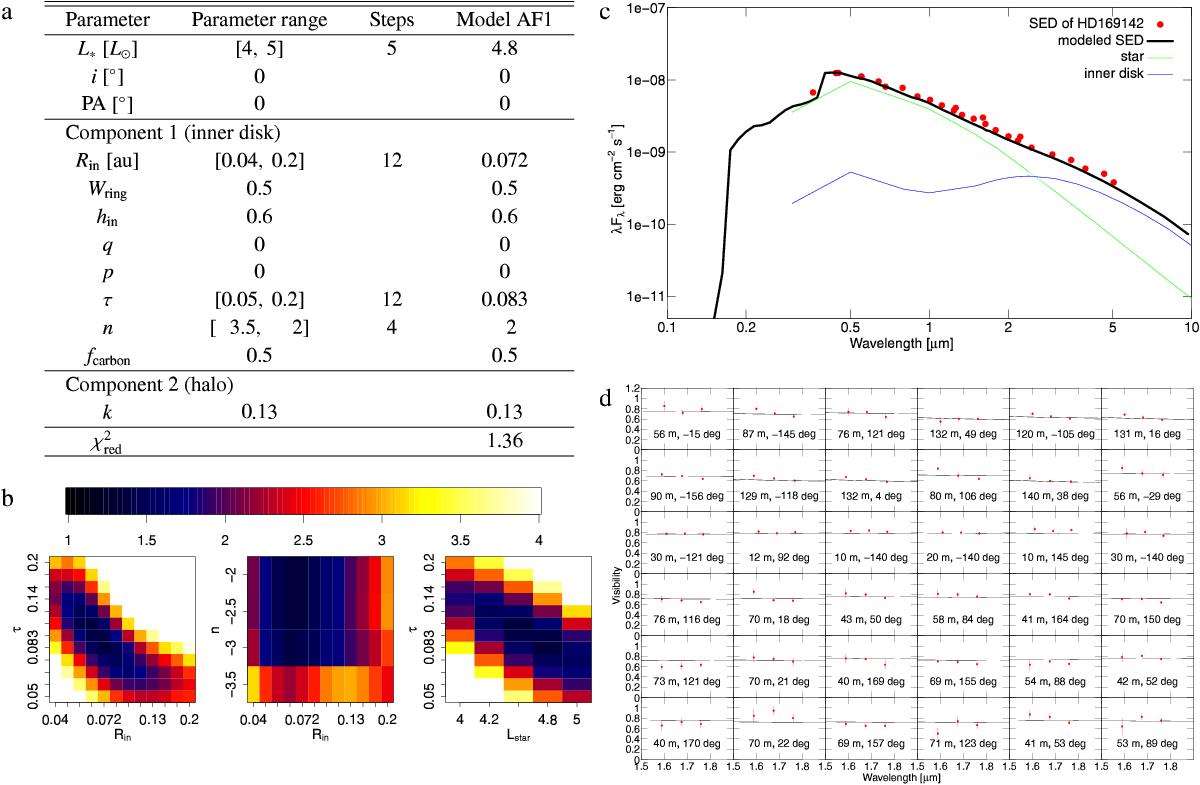Fig. 4

Model scanning run AF (optically thin inner disk), and the model parameters of the best model AF1 with minimum ![]() , which is calculated by comparing each model with the data set. Panel a: Parameter ranges of model scanning run AF, number of tested parameter values (steps) per parameter, and parameters of the best model AF1. The listed parameters are: L∗ = stellarluminosity; i = inclination of the disk; PA = positionalangleofrotationaxisthedisk; and the following parameters for the inner sub-AU disk; Rin = innerradiusoftheinnerdisk; Wring = (Rout−Rin) /Rin (relative radial width of the inner component); Rout = outerradiusoftheinnerdisk; hin = scaleheightoftheinnerdiskatitsinnerradius; q = scale - heightpower - lawindexoftheinnerdisk; p = surface - densitypower - lawindex; τ = Planck - averagedmidplaneopticaldepthat7500 K; n = power - lawindexofgrainsizedistribution; fcarbon = fractionofcarboninthedust. Panel b:
, which is calculated by comparing each model with the data set. Panel a: Parameter ranges of model scanning run AF, number of tested parameter values (steps) per parameter, and parameters of the best model AF1. The listed parameters are: L∗ = stellarluminosity; i = inclination of the disk; PA = positionalangleofrotationaxisthedisk; and the following parameters for the inner sub-AU disk; Rin = innerradiusoftheinnerdisk; Wring = (Rout−Rin) /Rin (relative radial width of the inner component); Rout = outerradiusoftheinnerdisk; hin = scaleheightoftheinnerdiskatitsinnerradius; q = scale - heightpower - lawindexoftheinnerdisk; p = surface - densitypower - lawindex; τ = Planck - averagedmidplaneopticaldepthat7500 K; n = power - lawindexofgrainsizedistribution; fcarbon = fractionofcarboninthedust. Panel b: ![]() maps of Model run AF.For each subset of parameters, the
maps of Model run AF.For each subset of parameters, the ![]() shown is the lowest value for all combinations with other paramters. For example, for each pair of (Rin, τ) values, the
shown is the lowest value for all combinations with other paramters. For example, for each pair of (Rin, τ) values, the ![]() values for all possible (L∗, n, fcarbon) combinations within the described ranges were compared and the minimum value found is plotted into the map at left panel. Panel c: SED of HD 169142. The lines denote the model contributions from different radial regions. The red dots are the observations. 5% uncertainty is assumed for each observation. Panel d: NIR visibilities (red dots: observations; black lines: model) from our VLTI/PIONIER observations.
values for all possible (L∗, n, fcarbon) combinations within the described ranges were compared and the minimum value found is plotted into the map at left panel. Panel c: SED of HD 169142. The lines denote the model contributions from different radial regions. The red dots are the observations. 5% uncertainty is assumed for each observation. Panel d: NIR visibilities (red dots: observations; black lines: model) from our VLTI/PIONIER observations.
Current usage metrics show cumulative count of Article Views (full-text article views including HTML views, PDF and ePub downloads, according to the available data) and Abstracts Views on Vision4Press platform.
Data correspond to usage on the plateform after 2015. The current usage metrics is available 48-96 hours after online publication and is updated daily on week days.
Initial download of the metrics may take a while.


